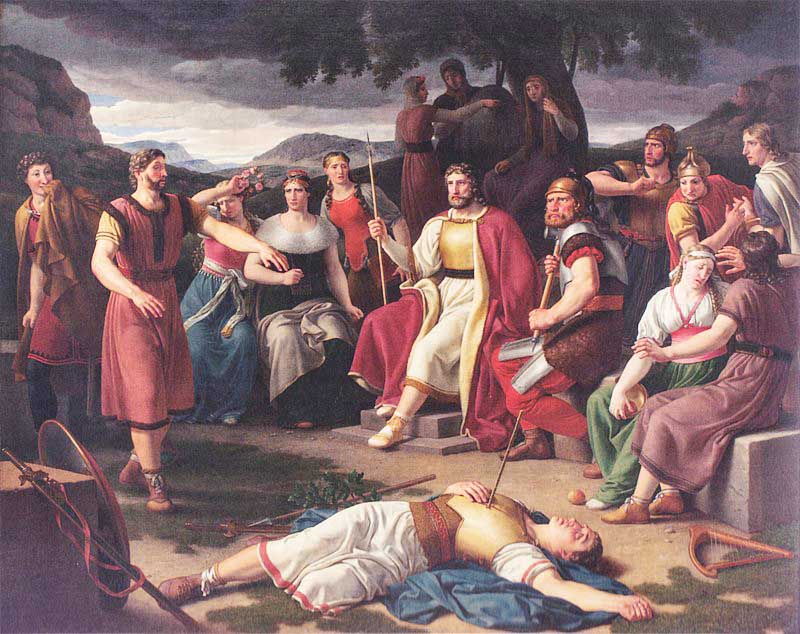
-

In old Norse Mythology the Aesir are the principal gods of the pantheon. They include many of the major figures, Odin, Frigg, Thor, Balder and Tyr.
A second clan of gods, the Vanir, is also mentioned in the Norse mythos. The god Njord and his children, Freyr and Freyja, are the most prominent Vanir gods who join the Aesir as hostages after a war between Aesir and Vanir. The Vanir appear to have mainly been connected with cultivation and fertility, the Aesir with power and war in the duality of mythology.
Mythology follows the patterns of birth, death, and rebirth in the alchemy of time and consciousness created by the patterns of Sacred Geometry - the Golden Ratio. The formula, which creates the lessons are about duality, with the godd and goddess pantheons, as well as the human DNA experience.
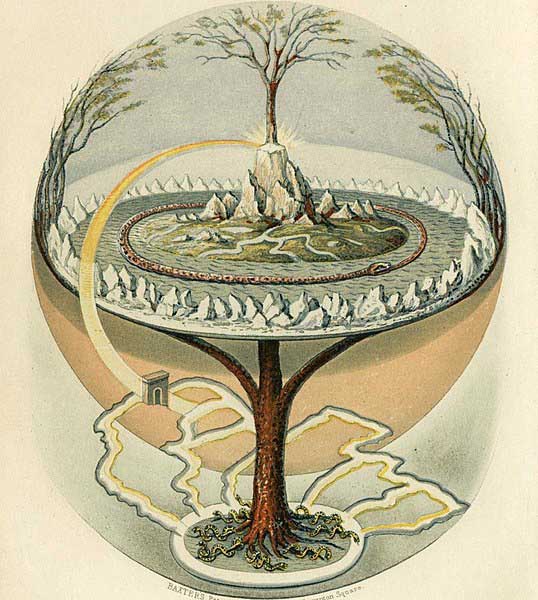
Yggdresil is a gigantic tree, thought to connect all the nine worlds of Norse cosmology. It is often suggested to be an ash tree, an interpretation generally accepted in the modern Scandinavian mind.
Ginnungagap was the vast chasm that existed between Niflheim [Land of Mist] and Muspelheim [fire giants] before creation. To the north of Ginnungagap lay the intense cold of Niflheim, to the south the insufferable heat of Muspelheim. At the beginning of time, the two met in the Ginnungagap; and where the heat met the frost, the frost drops melted and formed the substance eitr, which quickened into life in the form of the giant Ymir, the father of all Frost giants. See his entry for the continuation of the Old Norse story of the Creation. It is similar to Chaos Theory.
Ragnarok is the final battle, equivalent to Judgment day in the battle of good and evil, when balance is restored and a new creation begins.
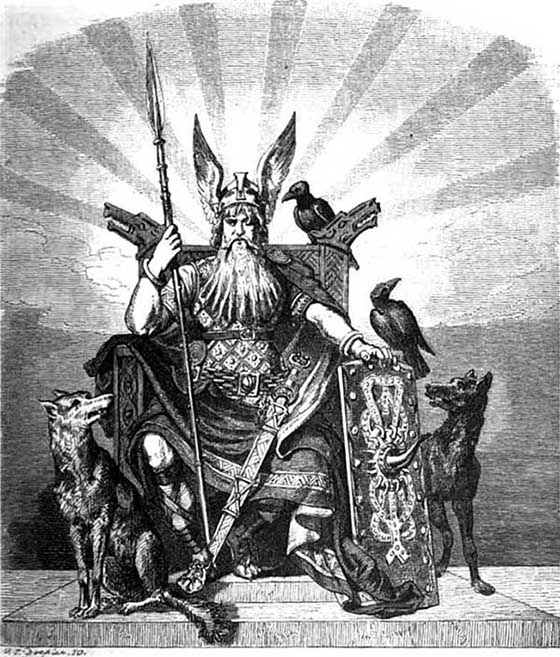
Odin is the chief divinity of the Norse pantheon, the foremost of the Aesir. Odin is a son of Bor and Bestla. He is called Alfadir, Allfather, for he is indeed father of the gods. With Frigg he is the father of Balder, Hod, and Hermod. He fathered Thor on the goddess Jord; and the giantess Grid became the mother of Vidar.
Odin is a god of war and death, but also the god of poetry and wisdom. He hung for nine days, pierced by his own spear, on the world tree. Here he learned nine powerful songs, and eighteen runes. Odin can make the dead speak to question the wisest amongst them. His hall in Asgard is Valaskjalf ("shelf of the slain") where his throne Hlidskjalf is located.
From this throne he observes all that happens in the nine worlds.
The tidings are brought to him by his two raven Huginn and Muninn. He also resides in Valhalla, where the slain warriors are taken.
Odin's attributes are the spear Gungnir, which never misses its target, the ring Draupnir, from which every ninth night eight new rings appear, and his eight-footed steed Sleipnir. He is accompanied by the wolves Freki and Geri, to whom he gives his food for he himself consumes nothing but wine. Odin has only one eye, which blazes like the sun. His other eye he traded for a drink from the Well of Wisdom, and gained immense knowledge. On the day of the final battle, Odin will be killed by the wolf Fenrir.
He is also called Othinn, Wodan and Wotan. Some of the aliases he uses to travel icognito among mortals are Vak and Valtam. Wednesday is named after him (Wodan).
Amongst his gifts to us, his children, was the greatest of all: the gift of writing. To accomplish this Odin hung himself upside down upon the World Tree, [Tree of Life] the gigantic ash Yggdrasil (a compound meaning "terrible horse").
After nine days of fasting and agony, in which "he made of himself a sacrifice to himself", he "fell screaming" from the tree, having had revealed to him in a flash of insight the secret of the runes. Their initial manifestation took the form of eighteen powerful charms for protection, increase, success in battle and love-making, healing, and mastery over natural causes.
This story illustrates an important dynamic of the Northern pantheon, which did not allow for omnipotence - even Odin must pay his due. At Mimir's well, which lay deep under the roots of Yggdrasil, the World Tree, the god had earlier chosen to undergo an important forfeit. Odin paid with one eye for a single drink of the enchanted water. His mouthful granted him wisdom and fore-sight. It is due to this sacrifice that Odin's face is depicted with a straight line indicating an empty eye, or alternately, in a wide-brimmed hat pulled down low over the missing orb.
His quest for knowledge was never-ending. Upon his shoulders perched two ravens, Hugin ("Thought"), and Munin ("Memory"). These circled the Earth each day, seeing all, and then at night reported to Odin what they had learnt. He cherished them both, but particularly Munin, which seems to underscore the importance he placed on rune writing, record keeping, and honouring the heroic deeds of the past. There is another bird associated with Odin, the eagle. The god often transformed himself into this canny raptor, both to view the workings of the world and to intervene when an avian form was better suited to his ends.
Odin's fabulous grey horse Sleipnir was like no other. This is the eight-legged horse depicted so beautifully on the painted stones of Gotland, a now-Swedish island in the Baltic. Sleipnir was the offspring of a giant's magical stallion and the "trickster" god, Loki, who disguised himself as an alluring mare to distract the stallion from the task of building a wall around Asgard, home of the Gods. If the wall had been completed by a certain date, Freyja, the goddess of beauty, war and sexuality would have been forfeit to the giant as payment for his labors. (The gods also stood to lose the Sun and the Moon, but did not seem particularly concerned about their impending loss!)
Loki was successful, but vanished for a few seasons as he had to bear the fruit of his trickery. He returned to Odin leading his equine offspring, which he presented as a gift. With his eight legs, Sleipnir could run twice as fast as ordinary steeds, and it is he who carries the valiant dead from the battle field to Valhalla.
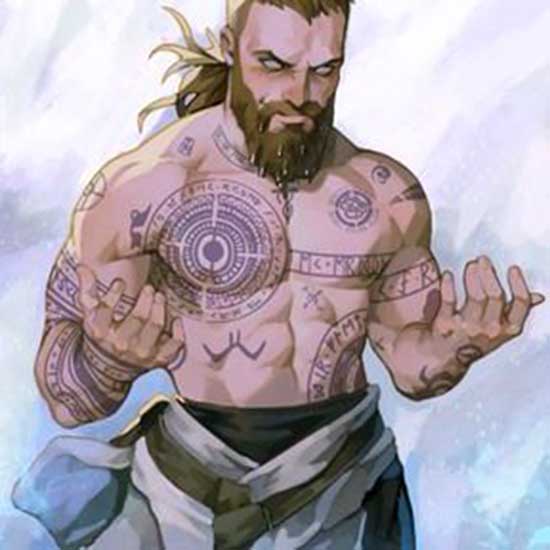
The god of light, joy, purity, beauty, innocence, and reconciliation. Son of Odin and Frigg, he was loved by both gods and men and was considered to be the best of the gods. He had a good character, was friendly, wise and eloquent, although he had little power.
His wife was Nanna daughter of Nep, and their son was Forseti, the god of justice. Balder's hall was Breidablik ("broad splendor"). Nanna is linked with the Sumerian goddess Inanna.
Most of the stories about Balder concern his death. He had been dreaming about his death, so Frigg extracted an oath from every creature, object and force in nature (snakes, metals, diseases, poisons, fire, etc.) that they would never harm Balder. All agreed that none of their kind would ever hurt or assist in hurting Balder. Thinking him invincible, the gods enjoyed themselves thereafter by using Balder as a target for knife-throwing and archery.
The malicious trickster, Loki, was jealous of Balder. He changed his appearance and asked Frigg if there was absolutely nothing that could harm the god of light. Frigg, suspecting nothing, answered that there was just one thing: a small tree in the west that was called mistletoe. She had thought it was too small to ask for an oath.
Loki immediately left for the west and returned with the mistletoe. He tricked Balder's blind twin brother Hod into throwing a mistletoe fig (dart) at Balder. Not knowing what he did, Hod threw the fig, guided by Loki's aim. Pierced through the heart, Balder fell dead.
While the gods were lamenting Balder's death, Odin sent his other son Hermod to Hel, the goddess of death, to plead for Balder's return. Hel agreed to send Balder back to the land of the living on one condition: everything in the world, dead or alive, must weep for him. And everything wept, except for Loki, who had disguised himself as the witch Thokk. And so Balder had to remain in the underworld.
The others took the dead god, dressed him in crimson cloth, and placed him on a funeral pyre aboard his ship Ringhorn, which passed for the largest in the world. Beside him they lay the body of his wife Nanna, who had died of a broken heart.
Balder's horse and his treasures were also placed on the ship. The pyre was set on fire and the ship was sent to sea by the giantess Hyrrokin.Loki did not escape punishment for his crime and Hod was put to death by Vali, son of Odin and Rind. Vali had been born for just that purpose.
After the final conflict (Ragnarok), when a new world arises from its ashes, both Balder and Hod will be reborn. Rising from the ashes goes to Egyptian mythos about the Phonnix she who rises from the ashes - resurrection and rebirth.
�As the wife of Odin, Frigg is one of the foremost goddesses of Norse mythology. She is the patron of marriage and motherhood, and the goddess of love and fertility. In that aspect she shows many similarities with Freya, of whom she possibly is a different form.
She has a reputation of knowing every person's destiny, but never unveils it. As the mother of Balder, she tried to prevent his death by extracting oaths from every object in nature, but forgot the mistletoe. And by a fig made from mistletoe Balder died.
Her hall in Asgard is Fensalir (water halls).
Frigg's messenger is Gna, who rides through the sky on the horse Hofvarpnir. In some myths she was rumored to have had love affairs with Odin's brothers Ve and Vili.
As Woden/Odin gave his name to Wednesday, and Thunor/Thor to Thursday, so Frigg is remembered in Friday. Frigg was the direct daughter of Fjorgyn, the Goddess of Earth. She kept her own hall, called Fensalir. Women prayed to her for children and prayed again for safe labor and delivery.
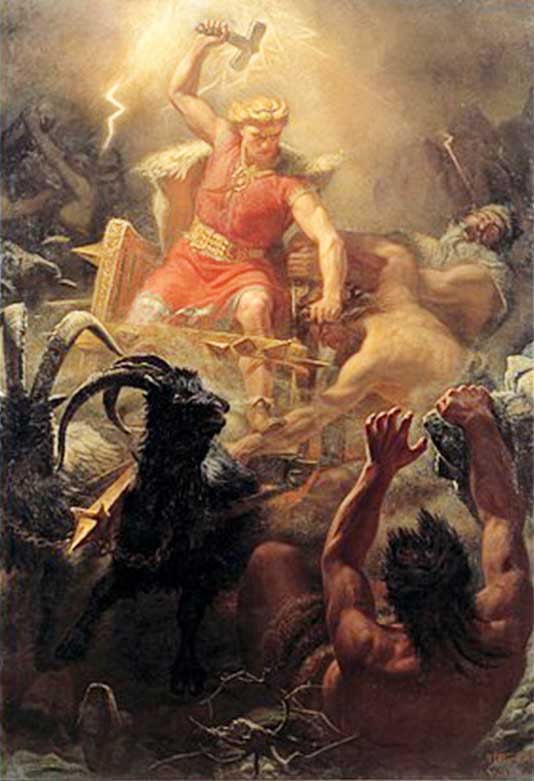
Thor is the Norse god of thunder. He is generally depicted as red-headed and bearded.
He is a son of Odin and Jord, and one of the most powerful gods. He is married to Sif, a fertility goddess. His mistress is the giantess Jarnsaxa ("iron cutlass"), and their sons are Magni and Modi and his daughter is Thrud.
Thor is helped by Thialfi, his servant and the messenger of the gods. who is Hermes in Greek Mythology and Mercury in Roman Mythology.
Thor was usually portrayed as a large, powerful man with a red beard and eyes of lighting. Despite his ferocious appearance, he was very popular as the protector of both gods and humans against the forces of evil. He even surpassed his father Odin in popularity because, contrary to Odin, he did not require human sacrifices.
In his temple at Uppsala he was shown standing with Odin at his right side. This temple was replaced by a Christian church in 1080.
The Norse believed that during a thunderstorm, Thor rode through the heavens on his chariot pulled by the goats Tanngrisni ("gap-tooth") and Tanngnost ("tooth grinder"). Lightning flashed whenever he threw his hammer Mjollnir.
Thor wears the belt Megingjard which doubles his already considerable strength.
His hall is Bilskirnir, which is located in the region Thrudheim ("place of might").
His greatest enemy is Jormungand, the Midgard Serpent.
At the day of Ragnarok, Thor will kill this serpent but will die from its poison. His sons will inherit his hammer after his death.
Donar is his Teutonic equivalent, while the Romans see in him their god Jupiter.
Thursday is named after him.
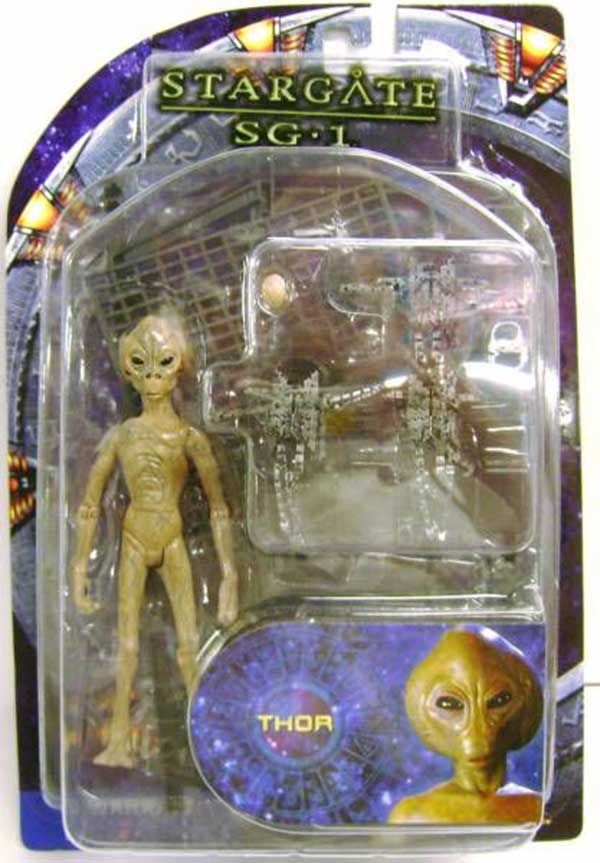
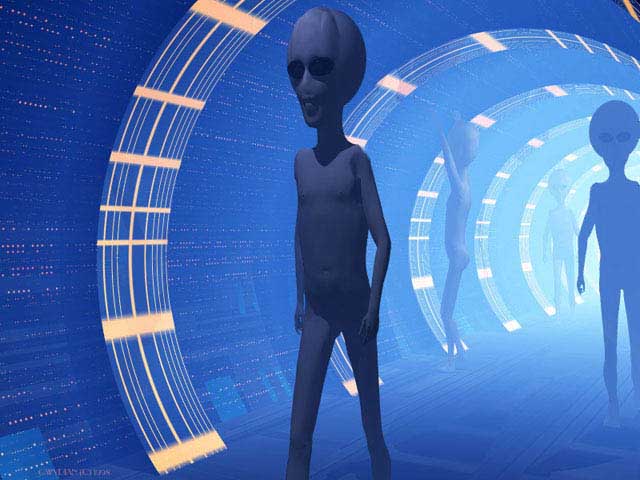
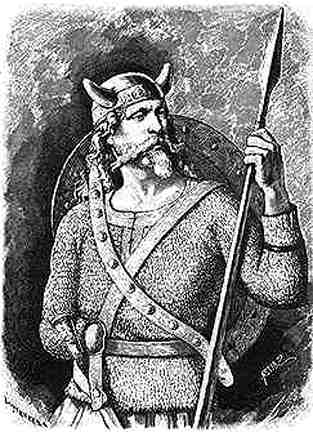
Try (aka Ziu ) wa the original Germanic god of war and the patron god of justice, the precursor of Odin. At the time of the Vikings, Tyr had to make way for Odin, who became the god of war himself.
Tyr was by then regarded as Odin's son (or possibly of the giant Hymir). He is the boldest of the gods, who inspires courage and heroism in battle.
Tyr is represented as a man with one hand, because his right hand was bitten off by the gigantic wolf Fenrir (in old-Norse, the wrist was called 'wolf-joint').
His attribute is a spear; the symbol of justice, as well as a weapon.
At the day of Ragnarok, Tyr will kill the hound Garm, the guardian of the hell, but will die from the wounds inflicted by the animal. In later mythology, "Tyr" became to mean "god".
He is also known as T”waz, Tiw and Ziu.
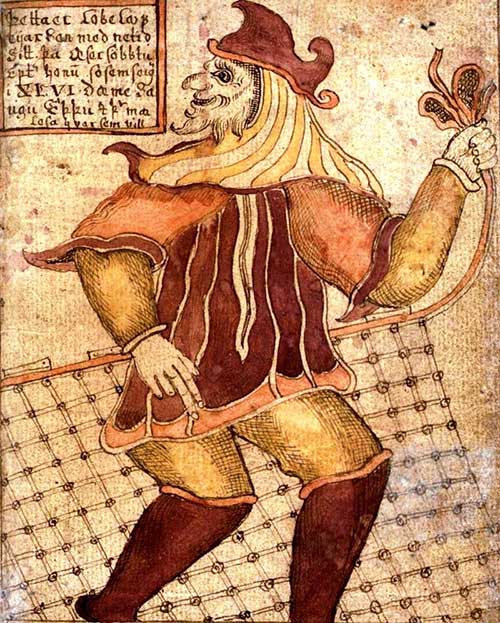
The most unpredictable and certainly the most dangerous god in the Northern pantheon was Loki. His activities ran from the merely mischievous to the blatantly malicious. Supremely clever, Loki ensnared everyone in complicated problems, to which he always supplied a remedy - through his solution often engendered even greater troubles.
His parents were both giants (the perpetual enemies of the gods.)
Loki is an immensely powerful magician, and shares with Odin the ability to sex and shape shift at will.
Loki was fair of face, and took many lovers, despite his constant criticism of goddesses who did the same.
His wife is Sigyn, who stayed loyal to him, even when the gods punished him for the death of Balder.
Loki's mistress is the giantess Angrboda. With her he is the father of three monsters.
He had some unusual children, including the huge wolf borne from Loki's brief dalliance with a giantess. Loki was the father (and in few instances the mother) of many creatures, men and monsters. Having liaisons with giantesses was nothing unusual for gods in Norse mythology - both Odin and Freyr are good examples; and since Loki was actually a giant himself, there is nothing unusual about this activity.
It is Loki who begins the chain of events that leads to the destruction of the gods. He does this by causing the death of the beautiful Baldr, Frigg's son, who in his goodness and perfection embodies the attainment of every desirable quality. Baldr's death plunges all of Asgard into mourning. Yet Loki feels no remorse, and in fact relishes every opportunity to exert his contrary nature.
Loki was chained to three large boulders; one under his shoulders, one under his loins and one under his knees. A poisonous snake was placed above his head. The dripping venom that lands on him is caught by Sigyn in a bowl. But every now and then, when the bowl is filled to the brim, she has to leave him to empty it. Then the poison that falls on Loki's face makes him twist in pain, causing earthquakes.
After Frigg had gone to great lengths to bring Baldr back to the land of the living by asking all beings to weep for his return, Loki (in the guise of an old female giant) steadfastly refused to shed a single tear for the slain god. Thus Baldr was consigned to the realms of the dead, under the governance of Lady Hel.
This loss of innocence represented by Baldr's death is the act that triggers Ragnarok, the end of all things. Ragnarok begins with famine and darkness and bitter cold - a winter lasting three entire years.
It ends with all creation becoming a flaming furnace. In the middle is staged the disastrous final battle in which the gods are arrayed against the powers of evil represented by the giants. Nearly everything and every body, in all realms, is destroyed. Loki fights against the gods, and is killed, as is Odin, Tyr, Freyr, and Thor.
Even the elves, dwarfs, Sun and Moon are destroyed. Out of this a new Earth arises, and a single man and woman, Lifthrasir and Lif, who had hidden themselves in Yggdrasil the World Tree, emerge. Baldr comes forth, and a few sons and daughters of the gods survive, and begin a fresh cycle of life.
This final lesson reminds us that nothing can remain static, even the gods and stories evolve into new.
Metaphors
Shape shifting, we play many roles simultaneously.
Trickster [duality, negative component] - Good vs. evil symbology.
Three - third dimension - 3D
World Tree - Tree of Life
Here we find another myth about birth, death, and resurrection. It reminds me of the story of Isis, Osiris and Horus.
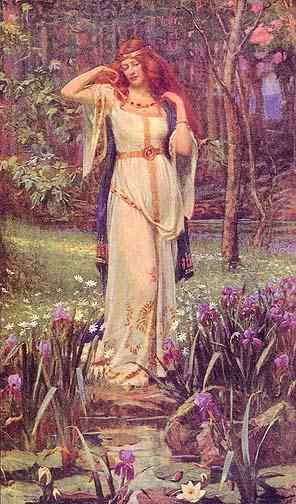
In Norse mythology, Freya is a goddess of love and fertility, and the most beautiful and propitious of the goddesses. She is the patron goddess of crops and birth, the symbol of sensuality and was called upon in matters of love. She loves music, spring and flowers, and is particularly fond of the elves (fairies). Freya is one of the foremost goddesses of the Vanir.
Goddess of sex, battle, and pleasure, most beautiful and desirable of white-armed women, Freyja was sister to the male fertility god Freyr. Freyja had unusual parity with Odin, for they divided the heroic dead amongst themselves. Half went to live eternally in Odin's hall, and half in Freyja's hall Sessrumnir- and the goddess got first pick.
As befits a goddess, Freyja owned potent magical equipment. Like Frigg, she possessed a falcon skin, which when pulled over her shoulders, allowed her to take the form of that raptor.This also provided a useful disguise when needed - important to a goddess whose personage made her instantly recognisable.
Freyja's most wonderful adornment was her necklace (or possibly a jeweled belt), Brisingamen.It was crafted by four dwarfs, and was of exceptional beauty.Freyja so longed for it that she consented to spend one night each in the arms of its makers as her payment.This was a just recompense in the eyes of the goddess, for as the necklace was the finest of all things the dwarfs could produce, the utter summation of their skill, why not repay them with an equally precious example of her love-art?
Freyja always wished to give her love freely.Her beauty and desirability often attracted the attention of those she did not want, such as the giant who offered to build an impregnable defensive wall around Asgard, the dwelling of the gods, in exchange for taking Freyja away as his wife. The goddess knew nothing of this agreement, and her outraged indignation at being so wagered grew the greater as the wall grew taller. Never believing they would have to forfeit Freyja, the gods grew more and more uneasy in their wager, until Loki ,who had urged the agreement, was forced to utilize his trickster ability to the fullest.
Three animals are associated with Freyja. She is pulled about in a cart to which two cats are harnessed. Their sinuous beauty and comfort-loving nature recall one side of the goddess. The other two animals are direct symbols of sexuality and strength.
Her golden-bristled boar is called Battle Swine (Hildisvini), and recalls her role as the receiver of heroic dead. Battle helmets topped with iron and bronze images of boars have been found throughout England and Scandinavia, for the boar's savage and cunning nature was widely revered. The other animal is the mare, associated with night, unbridled sexuality, and dangerous magical power. To "ride the night-mare" meant then, as now, to have bad dreams.
The golden-haired wife of the god Thor. There is not much known about her, except that she could originally have been a fertility goddess. Neither does she appear often in the myths.
The best know myth, however, is when Loki the Trickster sneaked into Sif's bedroom and lopped off her hair. Furious, Thor threatened to smash him unless Loki managed to replace the hair. He went to a great cave, the home of the sons of Ivaldi, and told them the reason of his journey. He then asked the dwarfs to spin gold as fine as Sif's hair and imbue it with magic that it will grow on her head. The dwarfs agreed and made a long wave of fine golden strands, which Loki gave to Sif.
The god of eloquence and poetry, and the patron of skalds (poets) in Norse mythology. He is regarded as a son of Odin and Frigg. Runes were carved on his tongue and he inspired poetry in humans by letting them drink from the mead of poetry. Bragi is married to Idun, the goddess of eternal youth. Oaths were sworn over the Bragarfull ("Cup of Bragi"), and drinks were taken from it in honor of a dead king. Before a king ascended the throne, he drank from such a cup.
In Norse mythology, Forseti is the god of justice. He is the son of the god Balder and his mother is Nanna. Forseti rules in the beautiful palace Glitnir, which serves as a court of justice and where all legal disputes are settled. Glitnir has a roof of silver that is supported by pillars of red gold. Forseti can be compared with the Teutonic god Fosite, who was worshipped on Helgoland.
Heimdall is the god of light, the son of nine mothers (variously given as the daughters of Geirrendour the Giant or of Aegir).
He was born at the end of the world and raised by the force of the earth, seawater and the blood of a boar.
Because of his shining, golden teeth he is also called Gullintani ("gold tooth").
His hall is Himinbjorg, The Cliffs of Heaven, and his horse is Gulltop.
Heimdall carries the horn Gjallar.
He is the watchman of the gods and guards Bifrost, the only entrance to Asgard, the realm of the gods.
It is Heimdall's duty to prevent the giants from forcing their way into Asgard. He requires less sleep than a bird and can see a hundred miles around him, by night as well as by day.
His hearing is so accurate that no sound escapes him: he can even hear the grass grow or the wool on a sheep's back. At the final conflict of Ragnarok he will kill his age-old enemy, the evil god Loki, but will die himself from his wounds.
As the god Rig ("ruler"), Heimdall created the three races of mankind: the serfs, the peasants, and the warriors. It is interesting to note why Heimdall fathered them, and not Odin as might be expected. Furthermore, Heimdall is in many attributes identical with Tyr.
Ve is one of a triad of ancient Scandinavian gods including Odin and Vili - sons of the primordial pair of giants Bor and Bestla. The three brothers created heaven and earth from the slain body of the primeval being Ymir and built the twelve realms. They also created the first pair of humans. The male was named Ask ("ash") and the female the named Embla ("elm"). Ask and Embla became the progenitors of the human race and Midgard was given to them as their residence.
In Norse myth, Midgar is the defensive fortress which the gods build about the middle portion of the Earth allotted to men in order to protect mankind from the giants. Midgard ("middle world") is on the same level as Nidavellir (land of the dwarfs), Svartalfheim (land of the dark elves/dwarfs) and Jotunheim (the land of the giants).
In Norse mythology, Ymir is the primordial giant and the progenitor of the race of frost giants. He was created from the melting ice of Niflheim, when it came in contact with the hot air from Muspell. From Ymir's sleeping body the first giants sprang forth: one of his legs fathered a son on his other leg while from under his armpit a man and women grew out.
The frost kept melting and from the drops the divine cow Audumla was created. From her udder flowed four rivers of milk, on which Ymir fed. The cow itself got nourishment by licking hoar frost and salt from the ice. On the evening on the first day the hair of a man appeared, on the second day the whole head and on the third day it became a man, Buri, the first god. His grandchildren are Odin, Ve and Vili.
Odin and his brothers had no liking for Ymir, nor for the growing number of giants, and killed him. In the huge amount of blood that flowed from Ymir's wounds all the giants, except two, drowned. From the slain body the brothers created heaven and earth. They used the flesh to fill the Ginnungagap; his blood to create the lakes and the seas; from his unbroken bones they made the mountains; the giant's teeth and the fragments of his shattered bones became rocks and boulders and stones; trees were made from his hair, and the clouds from his brains. Odin and his brothers raised Ymir's skull and made the sky from it and beneath its four corners they placed a dwarf.
Finally, from Ymir's eyebrow they shaped Midgard, the realm of man. The maggots which swarmed in Ymir's flesh they gave wits and the shape of men, but they live under the hills and mountains. They are called dwarfs.
ANCIENT AND LOST CIVILIZATIONS